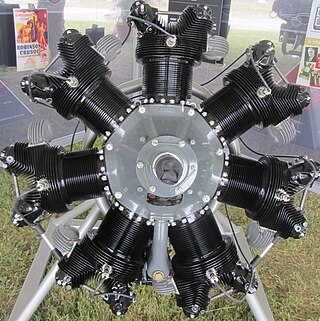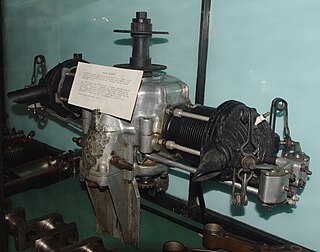Related Research Articles

The Allison V-3420 was a large experimental piston aircraft engine, designed in 1937 by the American Allison Engine Company.

The Continental R-670 was a seven-cylinder four-cycle radial aircraft engine produced by Continental displacing 668 cubic inches and a dry weight of 465 lb (211 kg). Horsepower varied from 210 to 240 at 2,200 rpm. The engine was the successor to Continental's first radial engine, the 170 hp Continental A-70. This engine was used on many aircraft in the 1930s and 1940s. The R-670 was widely used in the PT-17 Stearman primary training aircraft of the U.S. military.

The Potez 4D was a four-cylinder, inverted inline aircraft engine. It was first built shortly before World War II, but did not enter full production until 1949. Like the other D-series engines, the cylinders had a bore of 125 mm (4.9 in) and a stroke of 120 mm (4.7 in). Power for different models was in the 100 kW-190 kW (140 hp-260 hp) range.

The Praga Hostivař D was a four-cylinder, air-cooled, horizontally opposed aircraft engine first produced in Czechoslovakia in 1936 but which enjoyed its greatest success after World War II due to the explosion in popularity of sports flying. A version for helicopters was produced post World War II as the Praga DH

The Alfa Romeo 115 was an Italian six-cylinder air-cooled inverted inline engine for aircraft use, mainly for training and light planes, based on the de Havilland Gipsy Six engine. Production totalled approximately 1,600 units. Derivatives of the 115 include the -1, bis, ter and Alfa Romeo 116.

The Argus As 410 was a German air-cooled inverted V-12 light aircraft engine that was first produced by Argus Motoren in 1938.
The Hirth HM 506 was a six-cylinder air-cooled inverted inline engine that was developed from the earlier four-cylinder HM 504. The HM 506 was a popular engine for light aircraft of the 1930s to 1940s and powered the Bücker Bü 133A model trainer. The engine featured a cast magnesium alloy crankcase.

The Kinner B-5 was a popular five cylinder American radial engine for light general and sport aircraft of the 1930s.
The Kinner C-5 was an American five cylinder radial engine for small general and sport aircraft of the 1930s.

The Praga B2 was a low powered aero engine suitable for very light aircraft. It dates from the mid-1930s.
One of Avia's own designs, the 1930s Avia Rk.12 was a seven-cylinder radial engine with a rated output of 150 kW (200 hp), built in Czechoslovakia.

The Avia Rk.17 was a 9-cylinder radial aircraft engine, developed from the 7-cylinder Avia Rk.12, with a rated output of 270 kW (360 hp). The Rk.17 was one of Avia's own designs and was built in Czechoslovakia in the 1930s.
The Renault 4P, also called the Renault Bengali Junior, was a series of air-cooled 4-cylinder inverted inline aero engines designed and built in France from 1927, which produced from 95 hp (71 kW) to 150 hp (110 kW).

The Aeronca E-107 was one of the first low-cost reliable engines of the post-World War I era.

The Saroléa Albatros was a 22 kW (30 hp) flat twin air-cooled aircraft engine, produced just before World War II in Belgium.

The SNECMA-Régnier 4L is a French four cylinder air-cooled inverted inline piston engine, introduced shortly after the end of World War II.

The Potez 6D is a French six cylinder inverted inline aircraft engine put into production after World War II in normal and supercharged versions. Unsupercharged, it produced a take-off power of 179 kW (240 hp) at 2,530 rpm.
The Potez 8D is the largest member of the Potez D series of air-cooled piston aircraft engines which share several common features. It is a supercharged eight cylinder inverted engine with a take-off power of 373 kW (500 hp).
The Renault 6P, also called the Renault Bengali, was a series of air-cooled 6-cylinder inverted in-line aero engines designed and built in France from the late 1920s, which produced from 130 kW (180 hp) to 200 kW (270 hp).

The Fiat A.82 was an air cooled radial engine with 18 cylinders developed by the Italian engineering company Fiat and produced in small numbers during World War II. It was one of the most powerful aircraft engines produced in Italy and the culmination of series of successively larger engines developed from the A.74. It was used as the power plant for one operational aircraft, the Fiat BR.20bis bomber.